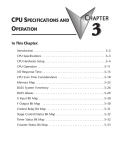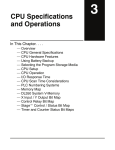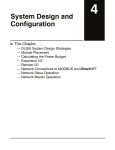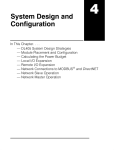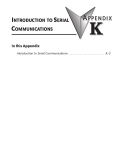Download DL250 / DL350 / DL450 CPU With T1K–RSSS
Transcript
DL250 / DL350 / DL450 CPU With T1K–RSSS Remote I/O System In This Chapter. . . . 14 Ċ DL250/D350/DL450CPU Bottom Port as Remote Master Ċ Remote Slave (T1K-RSSS) Features Ċ Configuring the Bottom Port of the DL250/DL350/450 CPU Ċ Setting the T1K-RSSS Rotary Switches Ċ Setting the T1K-RSSS DIP Switches Ċ Examples for Typical Configurations Ċ DL250/DL350/DL450 Reserved Memory for Bottom Port Ċ DL250/DL350/DL450 V Memory Port Setup Registers Ċ Connecting the Wiring Ċ Special CPU Memory for Diagnostics 4–2 DL250/DL350/DL450 CPU with T1K–RSSS Remote I/O System DL250/DL350/DL450 CPU Bottom Port as Remote Master For the D2–250, D3–350 CPU or D4–450, the most cost-effective way to add remote I/O is to use the bottom port of the CPU as a remote master. The restriction is that it operates in the RM–NET protocol only, which means a maximum of seven slaves at a maximum baud rate of 38.4 kBaud. Also, the slave serial communications port is not active in RM–NET protocol. This configuration requires some setup programming for the CPU. You can write your program using either a handheld programmer or DirectSOFT Programming Software. The examples that follow will show you how to do this using DirectSOFT. To get started, launch DirectSOFT and carry out the normal DirectSOFT setup procedures for communicating with your DL250, DL350 or DL450 CPU. If you do not know how to do this, refer to your DirectSOFT User Manual. Your PLC User Manuals have very good coverage of the basic commands available and examples of using the commands to write general ladder logic. We will be showing you in this chapter only those commands that pertain to setting up your remote I/O initialization. Built In Remote I/O Master Port DL250/DL350/DL450 CPU T1K–RSSS Remote I/O DL450 DL350 DL250 RM–NET Master Port 2 RM–NET Master Remote I/O Master Functional Specifications CPU built-in Remote I/O channels Maximum I/O points supported by each channel Maximum number of remote I/O slaves per channel DL250 DL350 DL450 1 1 1 2048* 2048* 2048* 7 7 7 Transmission Distance (max.) Communication Method Port 3 3900 feet (1.2Km) Asynchronous (half–duplex) X Inputs available for Remote I/O 512 512 1024 Y Outputs available for Remote I/O 512 512 1024 Control Relays available for Remote I/O 1024 1024 2048 V Memory (words) available for Remote I/O 7168 7168 14848 *Requires CPU firmware version: D2–250 version 1.51 or later, D3–350 version 1.30 or later, and D4–450 version (SH)1.460 or (SH)2.460 or later. Earlier firmware version supports 512 I/O points per channel. 4–3 DL250/DL350/DL450 CPU with T1K–RSSS Remote I/O System Remote Slave (T1K-RSSS) Features Top View Bottom View RUN--Turns ON when communication is active. DIAG--Turns ON when there is a slave hardware failure. I/OFast Blink: I/O error (250ms on/off time) Slow Blink: I/O configuration error while outputs are enabled (500ms on/off time) Continuous ON: I/O Configuration and I/O error simultaneously Output Enable Switch -T -1 -2 -3 Unit Address Switches Remote I/O Connector LINK--Turns ON when there is a communications error. Serial Port T1K-RSSS 1 PULL TO UNLOCK (Supported by SM–NET only) Remote I/O Connector Functional Max. # of Slaves per channel Specifications Maximum # of I/O Modules per Slave RM–NET 7 16 (be sure to check power budget) Module Type Non–intelligent slave Digital I/O Consumed Consumes remote I/O points at a rate equal to the number of I/O points configured in each unit. Communication Baud Rates RM–NET Selectable: 19.2K baud 38.4k baud Communication Failure Response Selectable to clear or hold last state of outputs DL250/DL350/DL450 CPU T1K–RSSS Remote I/O Maximum Remote I/O Points per CPU DL250, DL350 and DL450 support a maximum of 2048 points per channel. The actual I/O available is limited by total available references. For examNote: 8 channel analog modules ple, the DL250 has a total of 512 X inputs and consume 256 discrete I/O pts. 512 Y outputs. Mapping remote I/O into control and 16 channel analog modules relays or V memory of could allow more I/O consume 512 I/O pts. points for the DL250. V memory addressing is recommended when using analog I/O modules. 4–4 DL250/DL350/DL450 CPU with T1K–RSSS Remote I/O System The following specifications define the operating characteristics of the T1K–RSSS module. DL250/DL350/DL450 CPU T1K–RSSS Remote I/O Physical Installation Requirements Specifications mount to right of first power supply Base Power Requirement 250 mA maximum Communication Cabling for remote I/O, RS-485 twisted pair, Belden 9841 or equivalent Slave Serial Communications Port not active in RM–NET mode Operating Temperature 32 to 131° F (0 to 55_ C) Storage Temperature –4 to 158° F (–20 to 70_ C) Relative Humidity 5 to 95% (non-condensing) Environmental air No corrosive gases, pollution level = 2 (UL 840) Vibration MIL STD 810C 514.2 Shock MIL STD 810C 516.2 Noise Immunity NEMA ICS3–304 Impulse noise 1us, 1000V FCC class A RFI (144MHz, 430MHz, 10W, 10cm) 4–5 DL250/DL350/DL450 CPU with T1K–RSSS Remote I/O System Configuring the Bottom Port of the DL250/DL350/DL450 CPU To configure the port using the Handheld Programmer, use AUX 56 and follow the prompts, making the same choices as indicated below on this page. To configure the port in DirectSOFT, choose the PLC menu, then Setup, then Setup Secondary Comm Port. The port can also be configured using ladder logic code. S S Port: From the port number list box at the top, choose “Port 2” for the DL250 and DL350. Choose “Port 3” for the DL450. Protocol: Click the check box to the left of “Remote I/O” (called “M–NET” on the HPP), and then you’ll see the dialog box shown below. Setup Communication Ports Port: Protocol: Memory Address: Station Number: Baud Rate: S S K-sequence DirectNET MODBUS Non-sequence Remote I/O V37700 0 Close Help ChoosePort 3 for DL–450 38400 Memory Address: Choose a V-memory address to use as the starting location of a Remote I/O configuration table (V37700 is the default). This table is separate and independent from the table for any Remote Master(s) in the system. Station Number: Choose “0” as the station number, which makes the DL250, DL350 or DL–450 the master. Station numbers 1–7 are reserved for remote slaves. Baud Rate: The baud rates 19200 and 38400 baud are available. Choose 38400 initially as the remote I/O baud rate, and revert to 19200 baud if you experience data errors or noise problems on the link. Important: You must configure the baud rate on the Remote Slaves (via DIP switches) to match the baud rate selection for the CPU’s Port 2 (DL450 port 3). Then click the button indicated to send the Port 2 or Port 3 configuration to the CPU, and click Close. DL250/DL350/DL450 CPU T1K–RSSS Remote I/O S Port 2 4–6 DL250/DL350/DL450 CPU with T1K–RSSS Remote I/O System Setting the T1K–RSSS Rotary Switches The slave has two small rotary switches to set the unit address. They are on the face of the module, with the label “UNIT ADRS” beside it. Adjust the switches by rotating them with a small flathead screwdriver. Remote Slave Remote Master (DL250, 350 or 450) Address Selection Switches DL250/DL350/DL450 CPU T1K–RSSS Remote I/O Set Port 2 (Port 3 DL450) Address to 0 using DirectSoft or ladder logic code One switch is marked X1 and the other X10. Don’t confuse these with the conventional data type labeling – these do not refer to inputs X1 and X10. Instead, these set the address in decimal for each unit. X1 is the “one’s” position and X10 is the “ten’s” position. For example, set address 7 by turning the X10 switch to 0 and the X1 switch to 7. Set them to any number 1–7 for RM–NET. Two slaves cannot have the same number if they are linked to the same master. Always use consecutive numbers for slaves, starting with Address 1—don’t skip numbers. 4–7 DL250/DL350/DL450 CPU with T1K–RSSS Remote I/O System Setting the T1K–RSSS DIP Switches The remote slave has an 8–position DIP switch labeled “SW1” that is located on the side of the module under a hinged cover. Set these switches to configure the protocol mode, the baud rate, the output response on communication failure. The slave serial port is not active in RM–NET mode. The word “ON” appears beside the switch to indicate the ON position. Remote Slave (T1K–RSSS) DIP Switch located under hinged cover DIP Switches DIP Position Module 1 Slave 2,3,4 5 Mode Baud Rate Output Default OFF=SM–NET Switch Position OFF=Clear (T1K–RSSS) ON=RM–NET Baud Rate 2 3 4 ON=Hold 19.2K O O O 38.4K X O O Note: Higher baud rate are not supported by RM–NET 6,7,8 Serial Port not active in RM–NET mode DL250/DL350/DL450 CPU T1K–RSSS Remote I/O DIP Switch Settings 4–8 DL250/DL350/DL450 CPU with T1K–RSSS Remote I/O System Mode: DIP switch Position 1 on both the master and slave unit selects the protocol mode for the remote I/O link. Since the CPU port only supports the RM–NET protocol, Position 1 of the master and all slaves linked to it must be set to the ON position in order to communicate. Baud Rate: RM–NET protocol mode supports either 19.2K or 38.4K baud. In this mode, only switch Position 2 is used to set the baud rate. Be sure to set switches 3 and 4 OFF. All stations on a remote I/O link must have the same baud rate before the communications will operate properly. Output Default: DIP switch Position 5 on the slave determines the outputs’ response to a communications failure. If DIP switch 5 is ON, the outputs in that slave unit will hold their last state upon a communication error. If OFF, the outputs in that slave unit will turn off in response to an error. The setting does not have to be the same for all the slaves on an output channel. The selection of the output default mode will depend on your application. You must consider the consequences of turning off all the devices in one or all slaves at the same time vs. letting the system run “steady state” while unresponsive to input changes. For example, a conveyor system would typically suffer no harm if the system were shut down all at once. In a way, it is the equivalent of an “E–STOP”. On the other hand, for a continuous process such as waste water treatment, holding the last state would allow the current state of the process to continue until the operator can intervene manually . DL250/DL350/DL450 CPU T1K–RSSS Remote I/O WARNING: Selecting “HOLD LAST STATE” as the default mode means that outputs in the remote bases will not be under program control in the event of a communications failure. Consider the consequences to process operation carefully before selecting this mode. 4–9 DL250/DL350/DL450 CPU with T1K–RSSS Remote I/O System Example Program Using Discrete I/O Modules Example 1: Using X and Y Addresses as the Remote I/O Memory Types A typical system uses X and Y memory types for the inputs and outputs on the remote I/O channel. To illustrate the setup program for this configuration, we will use the remote I/O system below, shown with the completed Channel Configuration Worksheet. The first block of logic tells the CPU the station number of the port, communication V-memory address, and the baud rate setting. Define the constant value based on these selections (see DL250/DL350/DL450 Reserved Memory Table at the end of this chapter), and then write the value to the reserved V-memory address in the CPU. You can also perform this function interactively with DirectSOFT (see “Configuring the Bottom Port of the CPU“, earlier in this chapter). Write Port Setup Word DL350 CPU in Main Base (–1 base addressing) DL250 CPU in Main Base 250 CPU 16 16 16 16 16 I I I O O X0-X17 X20-X37 X40-X57 Y0-Y17 Y20-Y37 V40400 V40401 V40402 V40500 V40501 bottom port of CPU is remote master 16 16 16 16 O O I I 350 CPU Y60–Y77 Y40–Y57 X20-X37 X0-X17 V40503 V40502 V40401 V40400 bottom port of CPU is remote master to thoroughly understand addressing conventions and restrictions for the DL350, refer to the DL305 User Manual the setup program will be identical for either a DL250 or DL350 CPU Channel Configuration Worksheet DL250/DL350/DL450 CPU Bottom Port 1st Remote 16 I 16 8 16 16 I I O O Circle one selection or fill in blank for each parameter Configuration Parameter SELECTION Baud Rate (in KBaud), determined by required distance to last slave Remote I/O Configuration table Starting address 19.2 38.4 37700 V__________ (V37700 is default) X200–X217 X220-X237 X240-X247 Y200-Y217 Y220-Y237 V40410 V40411 V40412 V40510 V40511 2nd Remote PS T1K– RSSS Slave Station 8 8 16 I I O X260–X267 X270–X277 Y240–Y257 V40413 V40512 The port setup ladder code is optional. The port can be setup using DirectSoft SP0 LD OUT Kbfc0 Constant defines station as master, V-memory table at V37700, and baud rate of 38.4 kBaud V7656 V-memory address of setup word OUT V777 for DL450 See Port Setup Registers later in this chapter for more information 1 2 3 4 5 6 7 INPUT Input Address V40410 V40413 OUTPUT No. of Inputs Output Address No. of Outputs 48 16 V40510 V40512 32 16 DL250/DL350/DL450 CPU T1K–RSSS Remote I/O PS T1K– RSSS 4–10 DL250/DL350/DL450 CPU with T1K–RSSS Remote I/O System To calculate the input and output addresses and ranges, complete the Remote Slave Worksheets and fill in the V-memory addresses for each slave, not just the first one. You can transfer this data to the Channel Configuration Worksheet to condense it, or fill in the Channel Worksheet directly if you choose not to use the Remote Slave Worksheets. Calculate input and output addresses and ranges for each remote base 1st Remote PS T1K– RSSS 16 16 I 8 I 16 I Remote Slave Worksheet 1 Remote Base Address_________(Choose 1–7 for RM–NET or 1–31 for SM–NET) 16 O O X200–X217 X220-X237 X240-X247 Y200-Y217 Y220-Y237 V40410 V40411 V40412 V40510 V40511 2nd Remote INPUT OUTPUT Slot Number Module Name 0 16ND3 X200 1 16ND3 X220 16 2 08ND3 X240 16 (8 used) 3 4 Output Address No. of Outputs 16TD1 Y200 16 16TD1 Y220 16 Input Address No. of Inputs 16 5 PS T1K– RSSS 8 8 16 6 I I O 7 X260–X267 X270–X277 Y240–Y257 V40413 V40512 X200 Input Bit Start Address:________V-Memory Address*:V_______ 40410 48 Total Input Points_____ Y200 40510 Output Bit Start Address:________V-Memory Address*:V______ 32 Total Output Points_____ Channel Configuration Worksheet DL250/DL350/DL450 CPU Bottom Port Circle one selection or fill in blank for each parameter Configuration Parameter SELECTION Baud Rate (in KBaud), determined by required distance to last slave Remote I/O Configuration table Starting address DL250/DL350/DL450 CPU T1K–RSSS Remote I/O Slave Station 1 2 3 4 5 6 7 INPUT Input Address V40410 V40413 19.2 38.4 Remote Slave Worksheet 37700 V__________ (V37700 is default) OUTPUT No. of Inputs Output Address No. of Outputs 48 16 * The D2–RMSM automatically assigns I/O addresses in sequence based on Slave # 1’s starting addresses. The DL250/DL350/DL450 CPU port setup program requires these addresses for each slave. V40510 V40512 32 16 2 Remote Base Address_________(Choose 1–7 for RM–net or 1–31 for SM–NET) INPUT OUTPUT Slot Number Module Name Input Address 0 08ND3 X260 8 1 08ND3 X270 8 2 16TD1 No. of Inputs Output Address No. of Outputs Y240 16 3 4 5 6 7 X260 40413 Input Bit Start Address:________V-Memory Address*:V_______ 16 Total Input Points_____ Y240 40512 Output Bit Start Address:________V-Memory Address*:V_______ 16 Total Output Points_____ * The D2–RMSM automatically assigns I/O addresses in sequence based on Slave # 1’s starting addresses. The DL250/DL350/DL450 CPU port setup program requires these addresses for each slave. NOTE: Configuring remote I/O for the DL250, DL350 DL450 CPU port requires both the starting addresses and the number of input and output points for each slave. The starting addresses for each slave must be on a 16-point boundary. In this example, this means that X250–X257 in Slave # 1 are unused. 4–11 DL250/DL350/DL450 CPU with T1K–RSSS Remote I/O System The second block of logic tells the CPU, for each slave, the starting V-memory addresses for the inputs and outputs, and the total number of each. The CPU has reserved memory locations, called pointers, that accomplish this task. Use the values from the Remote Slave Worksheets or the Channel Configuration Sheet and the pointer addresses from the DL250/DL350/DL450 Reserved Memory Table to complete this logic. Write Input and Output Pointers and Ranges for each remote base DL250/DL350/DL450 Reserved Memory Table Port Setup Word V7656 Setup Complete Flag Channel Configuration Worksheet DL250/DL350/DL450 CPU Bottom Port Circle one selection or fill in blank for each parameter Configuration Parameter SELECTION Baud Rate (in KBaud), determined by required distance to last slave Remote I/O Configuration table Starting address Slave Station 1 2 3 4 5 6 7 INPUT Input Address V40410 V40413 19.2 38.4 37700 V__________ (V37700 is default) OUTPUT No. of Inputs Output Address No. of Outputs 48 16 V40510 V40512 32 16 Slave Input Address Number of Input Pts C740 Output Address Number of Output Pts 1 V37704 V37705 V37706 V37707 2 V37710 V37711 V37712 V37713 3 V37714 V37715 V37716 V37717 4 V37720 V37721 V37722 V37723 5 V37724 V37725 V37726 V37727 6 V37730 V37731 V37732 V37733 7 V37734 V37735 V37736 V37737 SP0 LDA O40410 Remote #1 Input V37704 reserved V–memory LD K48 V37705 LDA O40510 Output address V37707 LDA O40413 total outputs reserved V–memory Input address OUT V37710 reserved V–memory LD K16 OUT V37711 LDA O40512 total inputs reserved V–memory Output address OUT V37712 reserved V–memory LD K16 OUT V37713 total outputs reserved V–memory DL250/DL350/DL450 CPU T1K–RSSS Remote I/O K32 Remote #2 Output reserved V–memory V37706 reserved V–memory OUT Remote #2 Input total inputs OUT LD SP0 Input address OUT OUT Remote #1 Output V777 for DL450 4–12 DL250/DL350/DL450 CPU with T1K–RSSS Remote I/O System Once you have written all of the logic to map the starting addresses and point totals for each remote base, you have to zero out all of the reserved memory locations you are not going to use and then tell the CPU that you are finished with the setup. If you don’t insert zeros in the unused areas, the CPU will assume that every pointer address V37714 through V37736 is pointing to a read or write start address. This could cause problems; you may have garbage in these locations. At the very least, it will take up unnecessary scan time. The most efficient method for zeroing out the unused memory is to use LDD and OUTD instructions (load and store double) to clear two consecutive memory locations at a time. The following logic shows how to finish the setup program for this example. First scan relay contact SP0 There are 20 unused reserved memory locations. LDD K0 OUTD V37714 OUTD V37716 Load 32 bit accumulator with “0” Where the unused memory starts Clear all unused V-memory locations, 2 locations at a time OUTD V37720 OUTD V37722 OUTD V37724 OUTD V37726 OUTD V37730 SP0 OUTD V37732 DL250/DL350/DL450 CPU T1K–RSSS Remote I/O OUTD V37734 OUTD V37736 C740 SET Tell CPU that setup is completed 4–13 DL250/DL350/DL450 CPU with T1K–RSSS Remote I/O System Completed Setup Program for DL250/DL350/DL450 as Remote Master using X and Y Memory Addressing RLL Program SP0 K1 GTS Main Program Body SP0 Go to remote I/O subroutine K0 from bottom of previous column END Clear Unused Memory first scan relay SP0 Set port data LD Kbfc0 OUT V7656 LD port setup word K8 OUTD V37720 Constant defines port as master, V-memory table at V37700, and baud rate of 38.4 kBaud LD K500 OUT V7657 SP0 LDA O40410 Remote #1 Input V37724 OUTD Data selects Remote I/O OUTD V37726 LD K48 LDA O40510 K32 Clear Unused Memory OUTD V37734 OUTD V37736 Input address C740 SET Tell CPU that setup is completed total inputs reserved V–memory RT LD Output address LDA O40413 total outputs reserved V–memory Input address DL250/DL350/DL450 Reserved Memory Table Port Setup Word OUT V37710 reserved V–memory LD K16 OUT V37711 total inputs reserved V–memory V7656 Setup Complete Flag Slave Input Address Number of Input Pts C740 Output Address Number of Output Pts 1 V37704 V37705 V37706 V37707 O40512 Output address 2 V37710 V37711 V37712 V37713 OUT 3 V37714 V37715 V37716 V37717 4 V37720 V37721 V37722 V37723 total outputs 5 V37724 V37725 V37726 V37727 reserved V–memory 6 V37730 V37731 V37732 V37733 7 V37734 V37735 V37736 V37737 LDA V37712 reserved V–memory LD K16 OUT V37713 V777 for DL450 DL250/DL350/DL450 CPU T1K–RSSS Remote I/O V37707 to top of next column V37732 K5000 for DL450 (register setting provided) V767 for DL450 V37706 reserved V–memory OUT Remote #2 Output OUTD OUT LD Remote #2 Input V37730 SP0 V776 for DL450 V37704 reserved V–memory V37705 SP0 V37722 OUTD OUT OUT Remote #1 Output OUTD V777 for DL450 OUT V7655 OUTD V37716 Remote I/O Subroutine SBR K1 Load 32-bit accumulator with “0” OUTD Clear all unused VV37714 memory locations LDD 4–14 DL250/DL350/DL450 CPU with T1K–RSSS Remote I/O System Example Program Using Analog I/O Modules Example 2: Using V Memory Addresses as the Remote I/O Memory Type The following example uses Terminator discrete and analog I/O modules. It is recommended to use V memory addressing when using analog modules since each analog I/O channel uses a double (two) word each. Thus, an 8 channel analog I/O module uses 256 discrete points and a 16 channel analog I/O module uses 512 discrete points. Analog output modules are configured using the Module Control Byte located in the most significant byte of the most significant word of channel 1 of the module. V memory addressing requires the use of “Bit–of–Word” instructions to address the I/O points. DL250 CPU in Main Base Remote Slave Worksheet 250 CPU bottom port of CPU is remote master PS 16 16 16 16 16 I I I O O 1 Remote Slave Address_________(Choose 1–7 for RM–NET or 1–31 for SM–NET) T1K– RSSS 16 16 Input Address No. Inputs 0 16ND3 V3000 16 1 16ND3 V3001 16 2 08AD2 V3002 256 16 3 08DA2 V3100 256 O 4 16TD1 V3120 16 I I V3000 V3001 T1F–08AD–2 256 I 256 O OUTPUT Module Name X0-X17 X20-X37 X40-X57 Y0-Y17 Y20-Y37 V40400 V40401 V40402 V40500 V40501 1st Remote INPUT Module Number Output Address No.Outputs 5 V3002– V3021 V3100– V3120 V3117 6 7 T1F–08DA–2 2nd Remote PS T1K– RSSS 8 8 16 I I O DL250/DL350/DL450 CPU T1K–RSSS Remote I/O V3030 V3000.0 Input Bit Start Address:________V-Memory Address*:V_______ V3000 288 Total Input Points_____ V3100.0 V3100 Output Bit Start Address:________V-Memory Address*:V______ 272 Total Output Points_____ V3130 Channel Configuration Worksheet * The D2–RMSM automatically assigns I/O addresses in sequence based on Slave # 1’s starting addresses. The DL250/DL350/DL450 CPU port setup program requires these addresses for each slave. DL250/DL350/DL450 CPU Bottom Port Remote Slave Worksheet 2 Remote Base Address_________(Choose 1–7 for RM–net or 1–31 for SM–NET) Circle one selection or fill in blank for each parameter Configuration Parameter SELECTION Baud Rate (in KBaud), determined by required distance to last slave Remote I/O Configuration table Starting address Slave Station 1 2 3 4 5 6 7 19.2 38.4 V3000 V3030 OUTPUT No. of Inputs Output Address No. of Outputs 288 16 V3100 V3130 272 16 OUTPUT Module Name 0 08ND3 V3030 8 1 08ND3 V3030.10 8 2 16TD1 37700 V__________ (V37700 is default) INPUT Input Address INPUT Slot Number Input Address No. Inputs Output Address V3130 No.Outputs 16 3 4 5 6 7 V3030.0 V3030 Input Bit Start Address:________V-Memory Address*:V_______ 16 Total Input Points_____ V3130.0 V3130 Output Bit Start Address:________V-Memory Address*:V_______ 16 Total Output Points_____ * The D2–RMSM automatically assigns I/O addresses in sequence based on Slave # 1’s starting addresses. The DL250/DL350/DL450 CPU port setup program requires these addresses for each slave. 4–15 DL250/DL350/DL450 CPU with T1K–RSSS Remote I/O System This block of logic tells the CPU, for each slave, the starting V-memory addresses for the inputs and outputs, and the total number of each. Use the values from the Remote Slave Worksheets or Channel Configuration Worksheet and the pointer addresses from the DL250/DL350/DL450 Reserved Memory Table to complete the logic. Write Input and Output Pointers and Ranges for each remote base DL250/DL350DL450 Reserved Memory Table Port Setup Word V7656 Setup Complete Flag Slave Channel Configuration Worksheet DL250/DL350/DL450 CPU Bottom Port Circle one selection or fill in blank for each parameter Configuration Parameter SELECTION Baud Rate (in KBaud), determined by required distance to last slave Remote I/O Configuration table Starting address Slave Station 1 2 3 4 5 6 7 19.2 38.4 37700 V__________ (V37700 is default) INPUT Input Address V3000 V3030 Input Address Number of Input Pts V777 for DL450 C740 Output Address Number of Output Pts 1 V37704 V37705 V37706 V37707 2 V37710 V37711 V37712 V37713 3 V37714 V37715 V37716 V37717 4 V37720 V37721 V37722 V37723 5 V37724 V37725 V37726 V37727 6 V37730 V37731 V37732 V37733 7 V37734 V37735 V37736 V37737 OUTPUT No. of Inputs Output Address No. of Outputs 288 16 V3100 V3130 272 16 SP0 LDA O3000 Remote #1 Input OUT V37704 reserved V–memory LD K288 OUT V37705 LDA O3100 K272 V37707 LDA O3030 total outputs reserved V–memory Input address OUT V37710 reserved V–memory LD K16 OUT V37711 LDA Remote #2 Output Output address V37706 reserved V–memory OUT Remote #2 Input reserved V–memory OUT LD SP0 total inputs O3130 total inputs reserved V–memory Output address OUT V37712 reserved V–memory LD K16 OUT V37713 total outputs reserved V–memory Since the rest of the logic is identical to Example 1, we will now show the completed setup program. DL250/DL350/DL450 CPU T1K–RSSS Remote I/O Remote #1 Output Input address 4–16 DL250/DL350/DL450 CPU with T1K–RSSS Remote I/O System Completed Setup Program for DL250/DL350/DL450 as Remote Master using V Memory Addressing RLL Program SP0 K1 GTS SP0 Go to remote I/O subroutine Main Program Body K0 from bottom of previous column END Clear Unused Memory first scan relay SP0 LD OUT V7656 LD K8 port setup word OUT V7655 LD K500 OUT V7657 SP0 LDA O3000 Remote #1 Input OUTD V37720 Constant defines port as master, V-memory table at V37700, and baud rate of 38.4 kBaud OUTD V37722 OUTD Kbfc0 Set port data V37724 V777 for DL450 OUTD Data selects remote I/O OUTD V37726 V37730 V776 for DL450 SP0 K5000 for DL450 (register setting Provided) V767 for DL450 Clear Unused Memory OUTD V37732 V37734 OUTD C740 SET V37704 reserved V–memory K288 OUTD V37736 Input address OUT LD OUTD V37716 Remote I/O Subroutine SBR K1 Load 32-bit accumulator with “0” OUTD Clear all unused VV37714 memory locations LDD total inputs Tell CPU that setup is completed RT OUT reserved V–memory V37705 LDA O3100 DL250/DL350/DL450 CPU T1K–RSSS Remote I/O Remote #1 Output Output address Analog Programming example continued on next page OUT V37706 reserved V–memory LD K272 OUT V37707 SP0 LDA O3030 total outputs reserved V–memory Input address DL250/DL350/DL450 Reserved Memory Table OUT Remote #2 Input LD K16 OUT V37711 LDA O3130 Remote #2 Output Output address OUT V37712 reserved V–memory LD K16 OUT total outputs V37713 reserved V–memory to top of next column Setup Complete Flag total inputs reserved V–memory V7656 Port Setup Word V37710 reserved V–memory Slave Input Address Number of Input Pts C740 Output Address Number of Output Pts 1 V37704 V37705 V37706 V37707 2 V37710 V37711 V37712 V37713 3 V37714 V37715 V37716 V37717 4 V37720 V37721 V37722 V37723 5 V37724 V37725 V37726 V37727 6 V37730 V37731 V37732 V37733 7 V37734 V37735 V37736 V37737 V777 for DL450 4–17 DL250/DL350/DL450 CPU with T1K–RSSS Remote I/O System Completed Setup Program for V–Memory Addressing (con’t) Main Program Body V3002 – Bipolar – 0–5VDC SP1 SP0 Set Analog Output Module Control Bits SP1 LD BCD OUT V3500 B3101.10 OUT 0= All module outputs OFF 1= All module outputs Enabled B3101.11 SET 0= Unipolar 1=Bipolar B3101.12 RST V3002 > _ K2000 LD ADDB OUT V3100 K1FFF OUT V4000 Analog output data register OUT V3116 The OUT instruction sends the data to channel 1 of the analog output module C0 OUT B3030.0 Loads analog input channel 1 data into The INVERT and ADDB instructions convert the incoming 2’s compliment signal data to binary plus sign bit. K1 ANDD The BIN instruction converts the accumulator data to binary (omit this step if the conversion is done elsewhere.) BIN The OUT instructions stores the BCD data in a new register INV Read Negative Analog Input Data 0= 5V Range 1=10V Range Use the BCD instruction to convert thebinary analog input data to BCD if necessary to do math or other BCD operations V3000 the accumulator K2000 is used above to monitor the channel sign bit. It comes ON if the signal is negative. V2100 Loads analog input channel 1 data into V3000 the accumulator Analog Output Module Control Bits LD Send Data to Analog Output Module K2000 Read Positive Analog Input Data Configure T1K–08DA–2 Analog Output Module: Use X, C, etc. permissive contact if needed < Mask channel sign bit The OUT instructions stores the binary data in a new register. Add a BCD instruction prior to this OUT instruction if i is necessary to convert to BCD Channel 1 data is negative when C0 is ON B3130.12 Example of discrete remote OUT I/O point addressing The OUT instruction sends the data to channel 8 of the analog output module The Control Bits of an Analog Output module are located in the most significant byte of the most significant word of the first output channel (channel 1). Channel 1 Memory Map of 8&16-Channel Analog Output Module (T1F–08DA, T1F–016DA) 07 06 05 04 03 02 01 00 Octal Bit 07 06 05 04 03 02 01 00 Size Analog Value Channel 1 Write Byte 1 Analog Value Channel 1 Write Byte 2 not used Write Byte 3 Module Control Byte Write Byte 4 Module Control Byte of 8&16-Channel Analog Output Module (T1F–08DA, T1F–16DA) Decimal Bit 31 30 29 28 27 26 25 24 Octal Bit 37 36 35 34 33 32 31 30 Read/Write Bit 24 Outputs Enable 0 = All outputs OFF 1 = All outputs Enabled Write Bit 25 Unipolar / Bipolar 0 = Unipolar selected 1 = Bipolar selected Write Bit 26 5V / 10V Range 0 = 5V range 1 = 10V range Write Bit 27 0 – 20mA / 4–20mA Range 0 = 0 – 20mA range 1 = 4 – 20mA range Write Bit 28 – 31 Reserved for system use – DL250/DL350/DL450 CPU T1K–RSSS Remote I/O Decimal Bit 4–18 DL250/DL350/DL450 CPU with T1K–RSSS Remote I/O System DL250/DL350/DL450 Reserved Memory for Bottom Port as Remote Master This table provides a listing of the reserved memory addresses in the DL250/ DL350/DL450 CPU to program the pointer addresses and ranges for slaves attached to the bottom port of the CPU. DL250/DL350/DL450 Reserved Memory Table Port Setup Word Setup Complete Flag Number of Slave Input Reserved 1 2 3 4 5 6 7 V7656 V777(DL450) C740 Output Number of Address Input Points Address Output Points V37700 V37704 V37710 V37714 V37720 V37724 V37730 V37734 V37701 V37705 V37711 V37715 V37721 V37725 V37731 V37735 V37702 V37706 V37712 V37716 V37722 V37726 V37732 V37736 V37703 V37707 V37713 V37717 V37723 V37727 V37733 V37737 DL250/DL350/DL450 CPU T1K–RSSS Remote I/O This table provides a listing of the control relay flags available for the setup and monitoring of remote I/O attached to the bottom port of the DL250, DL350 and DL450 CPU. Control Relays Used For Remote I/O FLAG ADDRESS FUNCTION C740 Setup Complete Flag C741 Communications Error Response Flag DETAIL Set ON to command CPU to read and check parameters loaded into setup memory This flag determines the CPU’s response if there is a communications error. Set ON to hold last state of received inputs; set OFF to clear the status of the received inputs. 4–19 DL250/DL350/DL450 CPU with T1K–RSSS Remote I/O System DL250/DL350/DL450 V Memory Port Setup Registers When configuring the bottom port of the DL250, DL350 or DL450 CPU via DirectSoft or the Handheld Programmer, you are actually loading a reserved V-memory adddresses with configuration data. The following diagrams define the meaning of the bits in the registers. The previous ladder logic examples include logic in the setup program to set these parameters so they are not lost or accidentally changed. Remote I/O Communication Port Settings: DL250/DL350 (V7656); DL450 (V777) 15 8 7 0 LD Kbfc0 = V37700 as starting address pointer, OR 38.4k baud and address 0 LD K3fc0 = V37700 as starting address pointer, 19.2k baud and address 0 OUT V7656 (V777 for DL450) ******* * ******* * Station number setting 0 = Master station number Communication V–memory address (hex equivalent of octal adddress) default 37700 is starting address of pointer table Communication baud rate setting 0 = 19.2 kBaud 1 = 38.4 kBaud Port 2 Protocol Setup: DL250/DL350 (V7655) Port 3 Protocol Setup: DL450 (V776) 15 8 0 0 0 0 0 *0 0 0 LD K8 = Remote I/O OUT V7655 (V776 for DL450) 1 = Selects Remote not used for Remote I/O Register Set Code: DL250/DL350 (V7657); DL450 (V767) DL250/DL350: 15 8 ** **** ** 7 0 0 0 0 0 0 0 0 0 LD K500 = Port settings provided by user program OUT V7656 DL450: LD K5000 = Port settings provided by user program OUT V767 DL250/DL350 Port 2 register set code 0101(5) = register setting provided by user program DL450 Port 2 register set code 0101(5) = register setting provided by user program DL250/DL350/DL450 CPU T1K–RSSS Remote I/O 0 0 0 0 0 0 0 0 7 4–20 DL250/DL350/DL450 CPU with T1K–RSSS Remote I/O System Connecting the Wiring Cabling Between the D2–250 CPU Bottom Port and Slaves The standard remote I/O link is a 3-wire, half-duplex type. Since Port 2 of the DL250 CPU is a 5-wire full duplex-capable port, we must jumper its transmit and receive lines together as shown below (converts it to 3-wire, half-duplex). The recommended cabling for connecting the master and slaves is the single twisted pair cable, Belden 9841 or equivalent. The diagram also depicts the port pinout for the D2–250 CPU bottom port. Port 2 Pin Descriptions (DL250 CPU) 1 2 3 4 5 6 7 8 9 10 11 12 13 14 15 6 11 1 10 15 5 15-pin Female D Connector RXD– DL250 CPU Port 2 Remote I/O Master 0V 7 DL250/DL350/DL450 CPU T1K–RSSS Remote I/O RXD+ 5 VDC Transmit Data (RS232C) Receive Data (RS232C) Ready to Send (RS–232C) Clear to Send (RS–232C) Receive Data – (RS–422) Logic Ground Logic Ground Transmit Data + (RS–422) Transmit Data – (RS–422) Request to Send + (RS–422) Request to Send – (RS–422) Receive Data + (RS–422) Clear to Send + (RS422) Clear to Send – (RS–422) Remote I/O Slave (end of chain) Remote I/O Slave T Termination Resistor 5V TXD RXD RTS CTS RXD2– 0V 0V TXD2+ TXD2 – RTS2 + RTS2 – RXD2 + CTS2 + CTS2 – Jumper T TXD+ / RXD+ 1 1 TXD– / RXD– 2 2 TXD+ TXD– Signal GND 3 3 Internal 150 ohm resistor Connect shield to signal ground The twisted/shielded pair connects to the DL250’s Port 2 as shown. Be sure to connect the cable shield wire to the signal ground connection. A termination resistor must be added externally to the CPU, as close as possible to the connector pins. Its purpose is to minimize electrical reflections that occur over long cables. Be sure to add the jumper at the last slave to connect the required internal termination resistor. Ideally, the two termination resistors at T Add series the cable’s opposite ends and the external cable’s rated impedance will all three resistor 1 Internal match. For cable impedances greater 150 ohm than 150 ohms, add a series resistor at the resistor 2 last slave as shown to the right. If less than 150 ohms, parallel a matching resistance across the slave’s pins 1 and 2 instead. 3 4–21 DL250/DL350/DL450 CPU with T1K–RSSS Remote I/O System Cabling Between the D3–350/D4–450 CPU Bottom Port and Slaves The remote I/O link is a 3-wire, half-duplex type. Since Port 2 of the DL350 and Port 3 of the DL450 CPU is a 5-wire full duplex-capable port, we must jumper its transmit and receive lines together as shown below (converts it to 3-wire, half-duplex). The recommended cabling for connecting the master and slaves is the single twisted pair cable, Belden 9841 or equivalent. The diagram depicts the port pinout for the D3–350 and D4–450 CPU bottom port. The location of Port 2 on the DL350 is on the 25-pin connector , as pictured to the right. The location of Port 3 on the DL450 is on the 25–pin connector, which is also shared by Port 1. 0V Signal GND S Pin 7 S Pin 12 TXD+ 25 Pin Connector S Pin 13 TXD– DL350 Port 2 TXD+ DL450 Port 3 TXD– S Pin 24 RXD+ S Pin 25 RXD– 0V DL350 CPU Port 2 DL450 CPU Port 3 Remote I/O Master 7 Remote I/O Slave 1 13 14 25 RXD+ RXD– Remote I/O Slave (end of chain) T Termination Resistor Jumper T TXD+ / RXD+ 1 1 TXD– / RXD– 2 2 Signal GND 3 RXD+ TXD+ TXD– 13 25 RXD– 3 Internal 150 ohm resistor The twisted/shielded pair connects to the DL350/DL450’s Port as shown. Be sure to connect the cable shield wire to the signal ground connection. A termination resistor must be added externally to the CPU, as close as possible to the connector pins. Its purpose is to minimize electrical reflections that occur over long cables. Be sure to add the jumper at the last slave to connect the required internal termination resistor. Ideally, the two termination resistors at the cable’s opposite ends and the cable’s rated impedance will all three match. For cable impedances greater than 150 ohms, add a series resistor at the last slave as shown to the right. If less than 150 ohms, parallel a matching resistance across the slave’s pins 1 and 2 instead. Remember to size the termination resistor at Port 2 (Port 3 DL450) to match the cable’s rated impedance. The resistance values should be between 100 and 500 ohms. Add series external resistor T 1 2 3 Internal 150 ohm resistor DL250/DL350/DL450 CPU T1K–RSSS Remote I/O Connect shield to signal ground 4–22 DL250/DL350/DL450 CPU with T1K–RSSS Remote I/O System Special CPU Memory for Diagnostics This table provides a listing of the control relay flags available in the DL250/DL350/DL450 for remote I/O troubleshooting. Remote I/O System Control Relays FLAG ADDRESS FUNCTION Setup Error– The corresponding relay will be ON if the setup table contains an error (C750 =master, C751 = slave 1.....C757 = slave 7) C760 to C767 Communications Ready – – The corresponding relay will be ON if the setup table is valid (C760 =master, C751 = slave 1.....C767 = slave 7) DL250/DL350/DL450 CPU T1K–RSSS Remote I/O C750 to C757
























